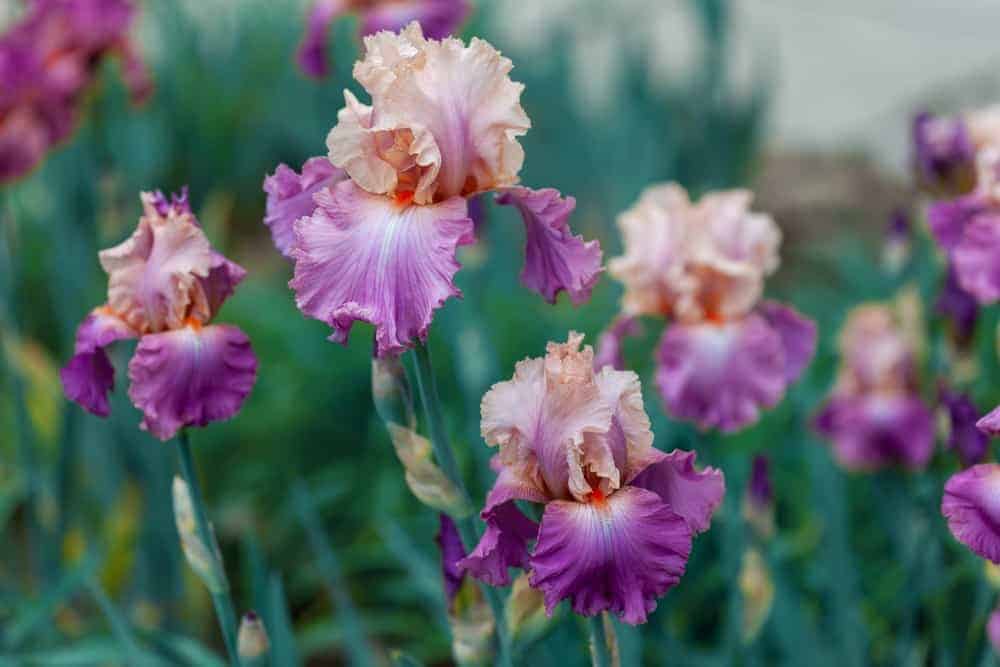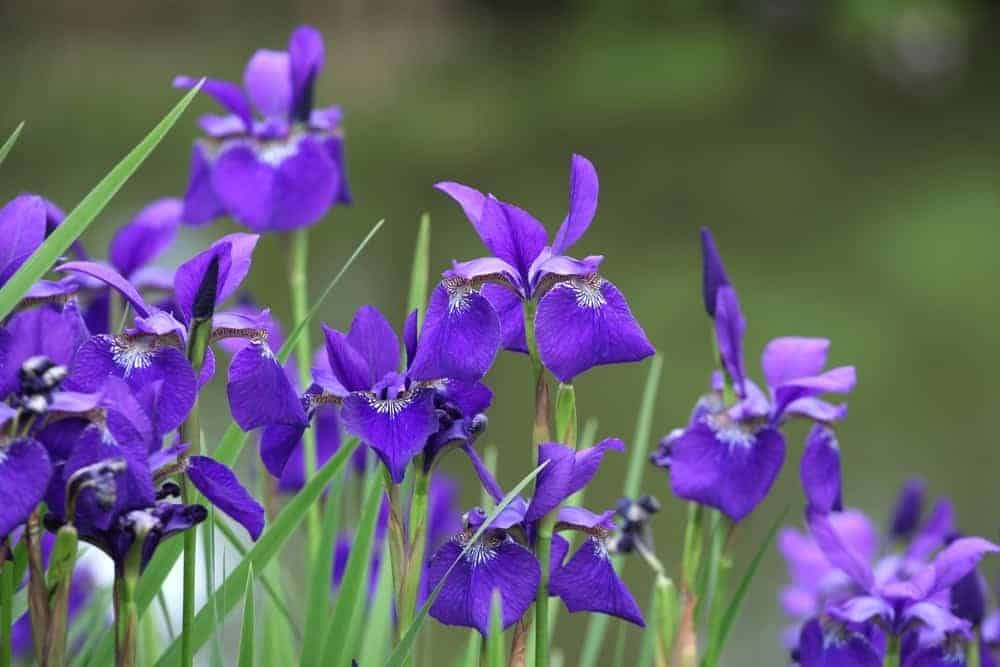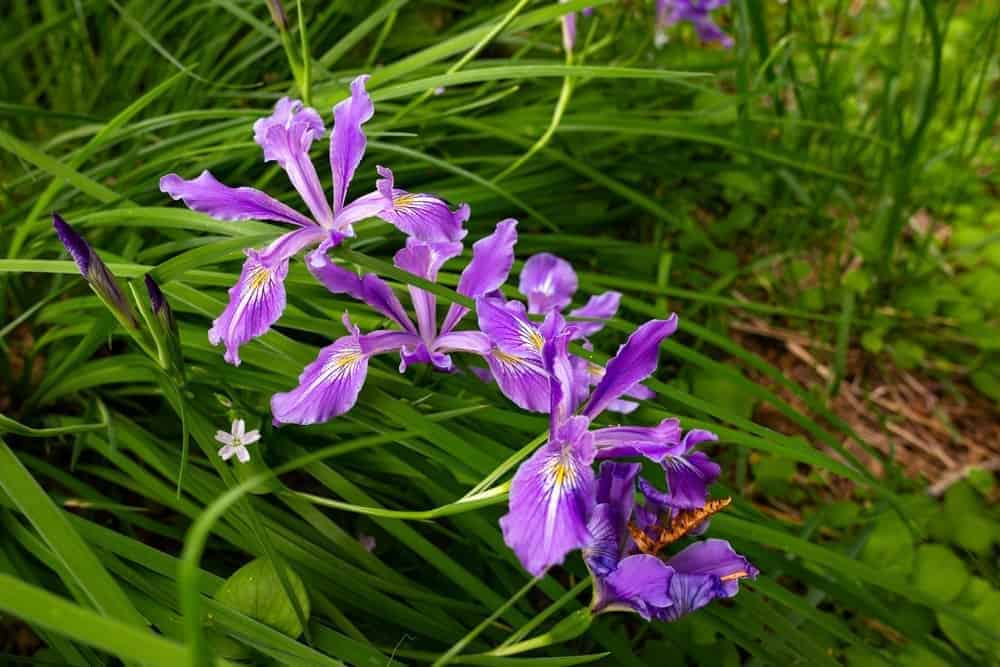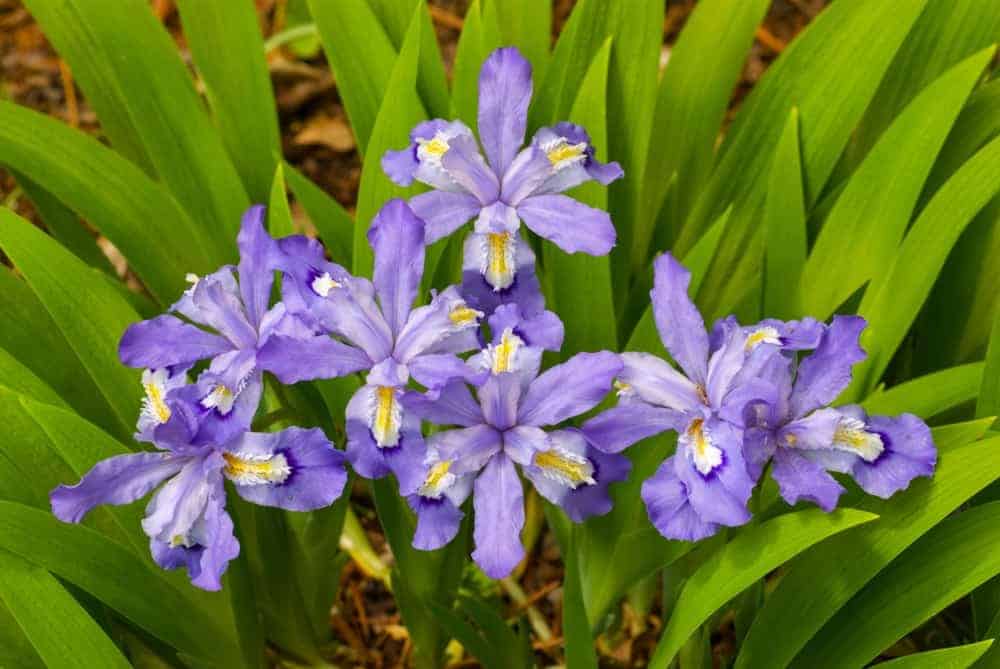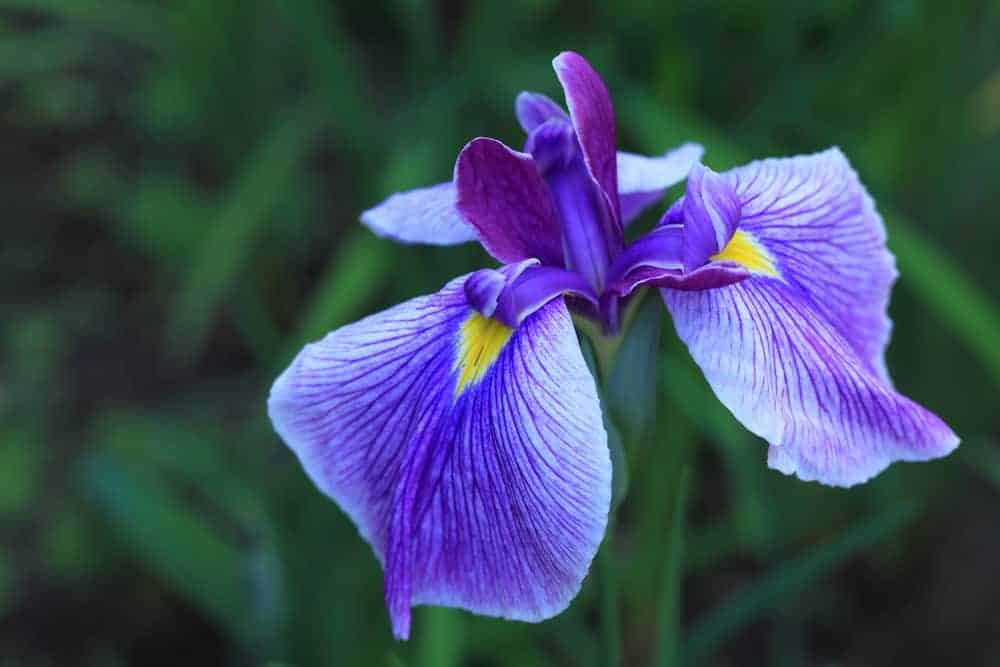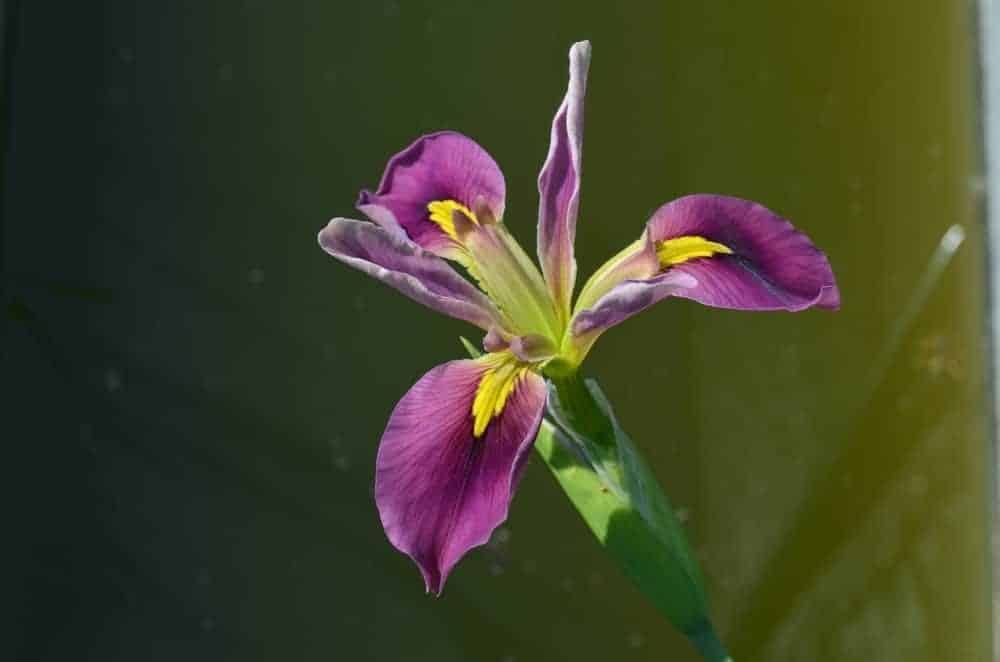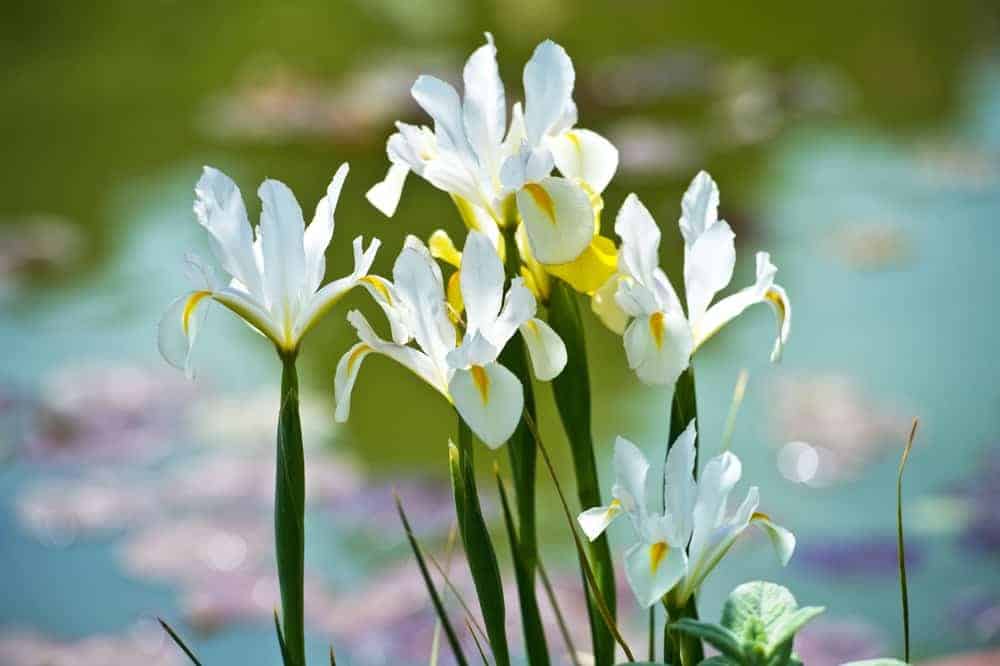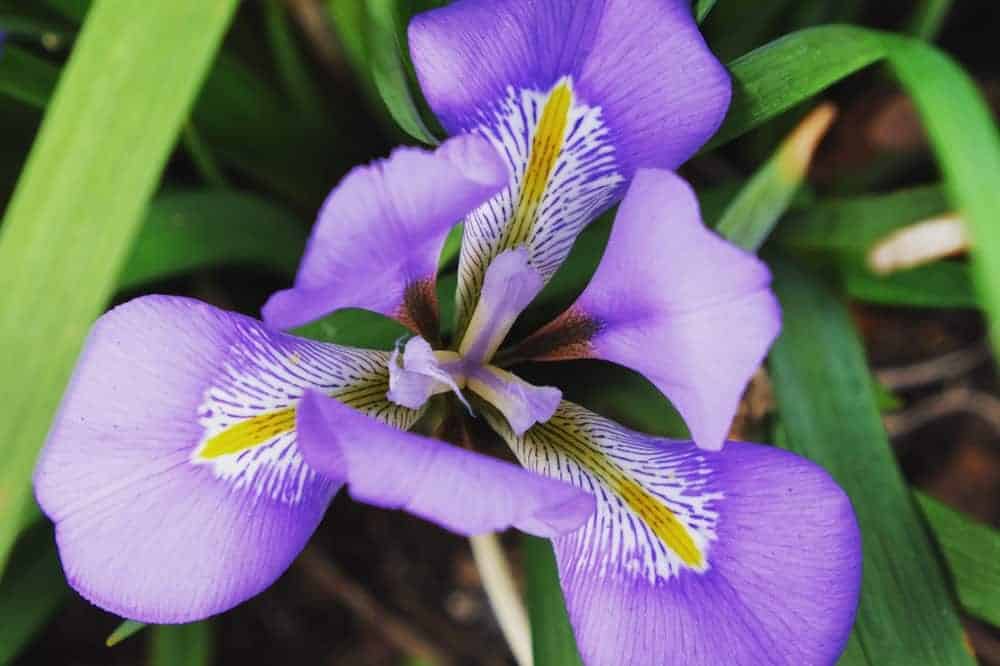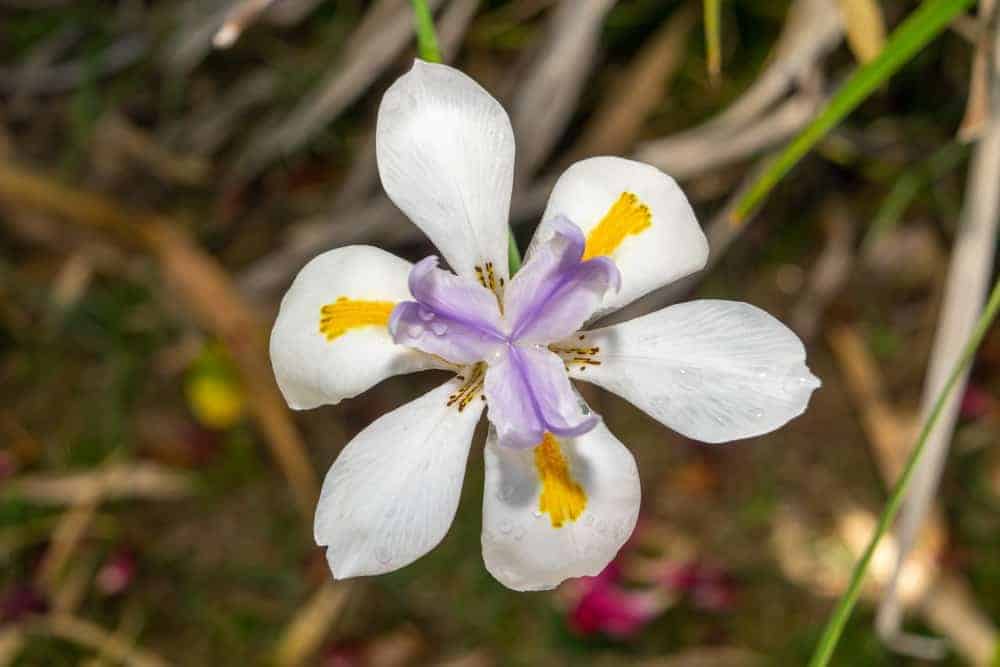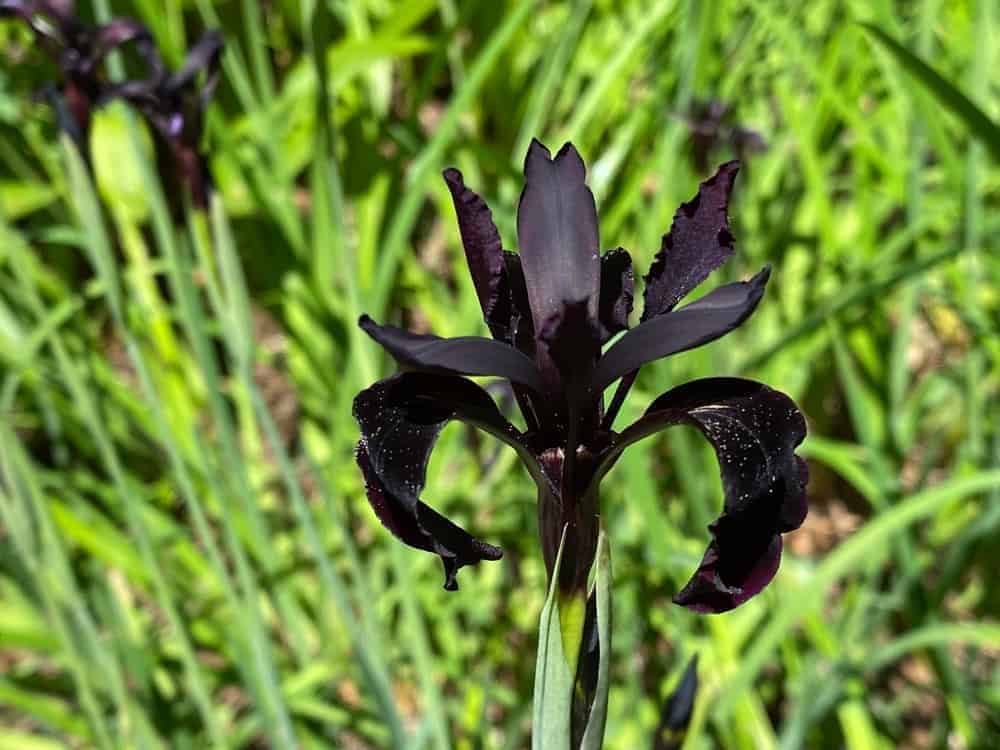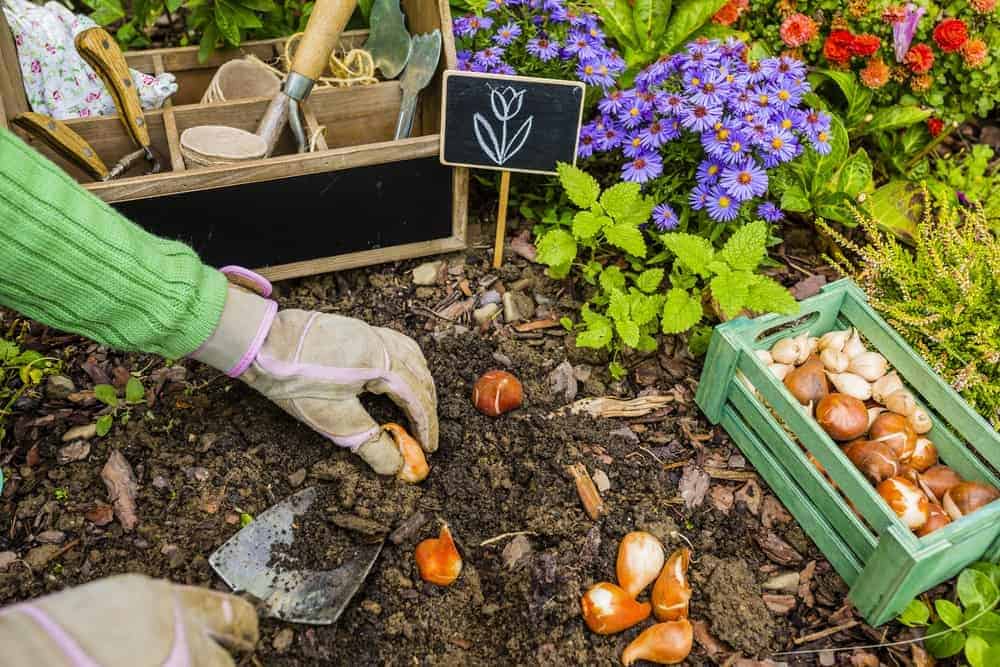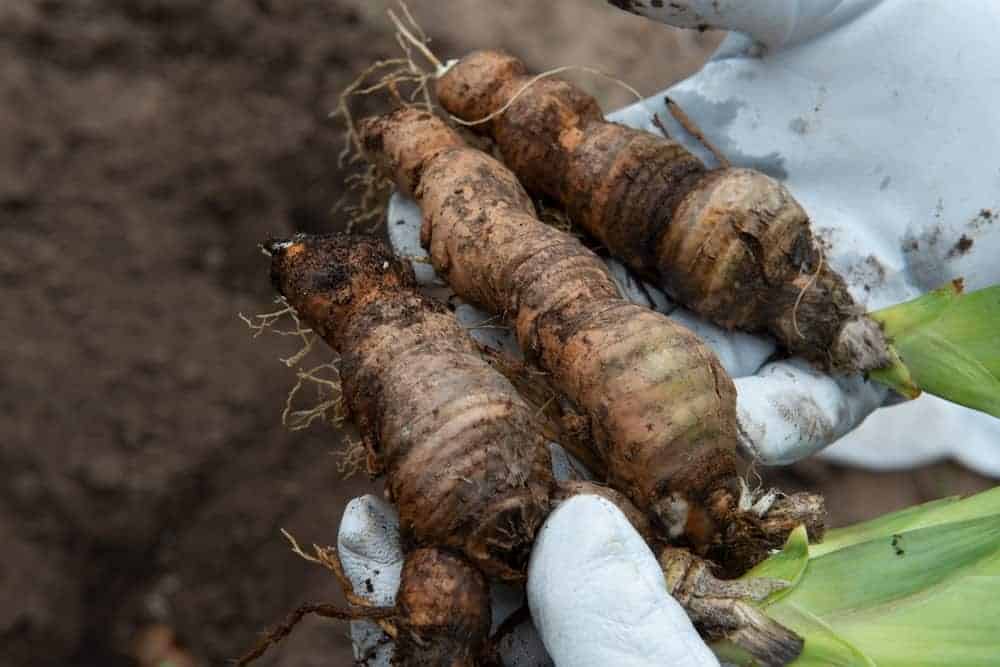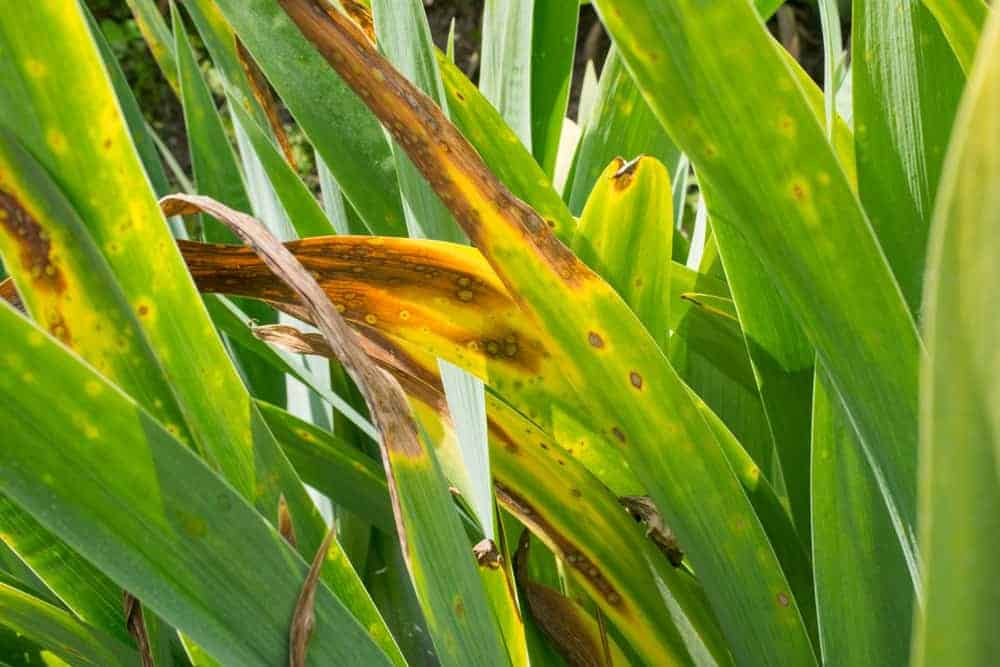Irises are a marvel of adaptability in gardening, boasting species that thrive in a wide range of conditions. From soggy soil and dappled shade to scorching sun and arid drought, these versatile flowers can tolerate it all. With an astonishing 300+ species to choose from, irises offer a kaleidoscope of colors and sizes to suit any gardening project or style.
Not only are they relatively easy to grow, but they’re also incredibly low maintenance.
Whether you’re a seasoned gardener or just starting out, irises are an excellent choice for beginners and experienced gardeners alike.
So, if you’re keen on growing irises, be sure to plant them in late summer or fall. This will give the plants time to establish themselves before winter, ensuring a brilliant display come springtime.
What Are Irises?
Irises, belonging to the herbaceous perennial family Iridaceae, have an intriguing growth habit. Each year, they die back to the soil, only to resurface from underground rhizomes or bulbs, allowing for new growth and a fresh start. This unique characteristic sets them apart from other perennials, such as tulips and daffodils.
Unlike these flowers, which typically bloom in early spring and then fade away, irises continue to thrive throughout the season, often keeping their leaves well into fall or even year-round for some species. Some varieties even boast variegated foliage, adding an extra layer of visual interest to the garden. In terms of blooms, irises are just as impressive. Their flowers can range from dramatic and full-bodied to delicate and understated, offering something for every taste.
It’s no wonder why so many people in your neighborhood might be growing irises – they’re easy to care for and offer a great deal of variety. Irises have a rich history, too. The flower has been used as a symbol by French nobility and Egyptian royalty, and the American Iris Society offers enthusiasts a platform to learn more about unique species and cultivars, share tips, and connect with like-minded individuals.
Interestingly, irises are named after the Greek goddess Iris, a messenger for the gods – a fitting namesake for a flower that attracts a wide range of pollinators, including hummingbirds.
Our Favorite Iris Hybrids and Species
While the showy bearded iris is undoubtedly a crowd-pleaser, the world of irises offers far more diversity than meets the eye. For those eager to explore beyond the familiar, here’s a rundown of ten lesser-known yet equally captivating types worth considering.
Bearded
Bearded irises, also known as germanica, are a long-term keeper that can thrive for up to 20 years under optimal conditions. These plants require six to eight hours of direct sunlight and prefer well-draining soil. One distinctive feature is the creeping rhizomes that emerge from the soil, coming in a range of sizes from dwarf to tall varieties. The dwarf types typically start blooming in March, while larger ones can begin flowering as late as June.
What’s more, these irises are renowned for their low-maintenance care. They don’t demand much attention, making them an ideal choice for busy gardeners. The smaller varieties can be successfully grown in pots, while the taller types make a stunning border plant. To ensure the taller types remain upright, we recommend providing support using garden stakes. It’s also essential to divide these plants every three to five years to keep them healthy and thriving.
Bearded irises are hardy in USDA Hardiness Zones 3-10, making them a versatile option for gardeners across the country.
Siberian
Siberian irises (I. sibirica) stand out with their delicate, petite blooms that differ significantly from those of the more prominent bearded iris. While they may not receive as much attention, they’re a great option for gardeners seeking to cultivate irises. This species thrives through rhizome roots and can tolerate partial shade, making it suitable for areas receiving three hours or more of sunlight.
Before planting, it’s essential to rejuvenate the rhizome by soaking it in clean water overnight. As the plant matures, it will form a dense cluster of foliage and flowers, reaching heights of up to 34 inches over time. When necessary, divide the plants to maintain their health and promote continued growth. Siberian irises typically bloom after the taller bearded iris and are hardy in Zones 3-9.
Toughleaf
Toughleaf iris (Iris tenax) stands out as a fantastic groundcover option, hailing from northwestern California, western Oregon, and southwestern Washington. While they may not boast the largest or most showy blooms, their flowers are ideal for posies and remain long-lasting from late spring to mid-summer. The plants reach up to 12 inches in height, boasting dark green foliage, and produce blooms that range in hue from creams and yellows to blues and purples.
This species is also known as the Pacific Coast bearded iris, boasting heat tolerance and an ability to thrive in partially shaded areas. With a preference for well-draining soil like sand or loam, it can even tolerate partial clay but will struggle if its rhizomes are submerged in water. Toughleaf iris is suitable for growth in USDA Zones 5-9.
Dwarf Crested
A standout variety, dwarf crested iris (I. cristata) is well-suited to woodland-style gardens with peat-based soils due to its compact growth habit, reaching only six inches in height. Its rarer cousin, dwarf iris (I. verna), shares a similar appearance. Native to eastern North America, this species has gained popularity among iris enthusiasts.
One of its defining characteristics is the striking combination of violet-blue to purple-tinged petals with subtle hints of yellow and white at the center. This low-growing perennial spreads via rhizomes beneath the soil, making it an excellent choice for filling in gaps. To thrive, dwarf crested irises require humus-rich soil and ample moisture in pots or shallow borders. They are ideally suited to USDA Zones 5-8.
Blue Flag
For gardeners looking to create a unique and thriving environment, blue flag irises (I. versicolor) are an excellent choice for areas featuring standing water, such as pondside or bog gardens. As an aquatic perennial, this plant has high water requirements and does best in clay-based or loamy soil.
Native to the eastern United States, blue flag iris is well-suited to establish itself quickly in suitable conditions.
While it appreciates full sun, it can also thrive in low-light areas, producing blooms from spring to summer in Zones 3-9.
Louisiana
The Louisiana iris (I. hexagona) is a striking sight to behold, boasting massive blossoms that can reach up to four inches in diameter. The vibrant petals display an impressive range of colors across the rainbow spectrum, including cream, blue, bronze, white, yellow, pink, red, purple, and nearly black hues.
Native to the wetlands of Louisiana, this iris species is well adapted to tolerate some standing water, making it a popular choice for those looking to add a touch of aquatic charm to their gardens. While its growing requirements differ from many other irises, with proper care, hybrids can thrive in a wide range of conditions. One key consideration is providing adequate mulching around the rhizomes – unless they’re nestled in water or boggy soil, that is.
As for sunlight, this iris prefers six to eight hours of direct sun, but will also tolerate some shade in zones 4-10.
Dutch
Dutch irises (Iris hollandica) are a showstopper with their stunning flowers perched atop stems that can reach an impressive 22 inches in height. But what’s equally noteworthy is the bulbous base of these plants, which are shaped like teardrops and give rise to the dramatic display above. This hybrid iris has earned its place among flower farmers and florists for its dependable straight stems, remarkable durability, lengthy vase life, and kaleidoscope of colors.
Whether you’re looking for low-maintenance or versatility, this variety checks both boxes – provided it receives six-to-eight hours of sunlight, even if that’s in partial shade. As an added precaution, the tall stems may require staking to prevent them from toppling over in windy areas. If you’re planning to grow irises, look no further than Dutch iris for Zones 5-9.
Algerian
The Algerian iris (I. unguicularis) is a stunning variety that blooms from late fall to early spring, producing lavender-hued flowers on stems that reach 18 inches tall. Its slender leaves have a grass-like appearance. As the seeds take time to germinate, it’s essential to exercise patience when growing this species from scratch.
To coax out the full splendor of this iris, provide it with a sheltered spot that receives plenty of sunlight.
The vibrant purple petals and yellowish-orange throats are sure to delight. One key to success is ensuring the plant remains in the same location, as it’s sensitive to root disturbance.
Hardy in Zones 7-9, this iris thrives in conditions that allow it to put down deep roots and establish a strong foundation.
Douglas
The mini iris (I. douglasiana) has garnered popularity due to its remarkable hardiness and adaptability to various environments. It thrives in rockeries, small spaces, shaded areas, windy spots, pots, and garden borders, making it an ideal choice for many gardeners. This charming wildflower, native to the Pacific Coast region, boasts a striking appearance featuring a pale lavender hue with a yellow throat.
Breeders are actively working on creating a more diverse color palette and hybrid varieties, with options ranging from deep purple to white, lilac, blue, and even deep red. One of its notable characteristics is its low water requirement, making it an excellent choice for gardeners in Zones 6-9 who prefer free-draining soils.
Black
The standout black irises (Iris chrysographes) are a rare find in the garden. Reaching up to 20 inches in height and boasting almost black, purple blooms, they’re instantly recognizable. For those looking to create a dramatic, monochromatic display in their black-themed garden, this species is the perfect choice.
Tolerant of both full sun and partial shade, as well as some standing water, these adaptable irises can thrive near water features, in wild meadow gardens, or in large pots and borders.
A dependable performer, black irises produce lush, large blooms reminiscent of their bearded iris cousins.
As the plants mature, they spread via rhizome roots, requiring division every five years to maintain optimal growth.
Hardy to Zones 3-9, these resilient irises are a great addition to any garden seeking unique character.
Growing Irises
Whether cultivating irises from bulbs, seeds, or rhizomes, it’s essential to provide the right conditions for optimal growth. In general, most iris species require full sun to produce an abundance of blooms. While some may tolerate partial shade, they typically need at least six hours of direct sunlight per day. A few exceptions exist, but these are the exception rather than the rule. When planting irises in the garden, timing is crucial.
For spring and summer flowering, plant bulbs or rhizomes in the fall, around October. In regions with extended winters, you may even have time to plant as early as September. Irises growing from rhizomes benefit from having some of their root system exposed above soil level, except for Louisiana irises, which require a layer of mulch over the rhizome. When sowing seeds or planting bulbs, bury them at a depth that allows for adequate sunlight penetration.
For bulbs, this typically means planting about half to three-quarters inch deep, while seeds should be just barely covered. Taller varieties may appreciate support structures during unpredictable weather or in more exposed areas of the garden. Watering needs can vary significantly depending on the iris species. Some thrive in standing water, while others prefer dry soil. It’s essential to research the specific watering requirements for your particular variety.
In terms of general care, most irises benefit from well-draining soil and an all-purpose fertilizer applied every eight weeks before and after blooming. Consider pairing your irises with companion plants like alliums, daylilies, peonies, tulips, larkspur, daffodils, lavender, grasses, and poppies for a lush and vibrant garden.
How to Divide
When it’s time to replant irises, you’ll know they’ve outgrown their compacted roots due to age and limited root expansion. This process typically begins when the plant’s health starts to decline after years of being in one spot. The ideal time for division is just after flowering, before the first frost sets in. If you’re dealing with clumping varieties like Algerian irises, wait until late winter or early spring to give the roots sufficient time to regrow before the next winter arrives.
With multiple methods available depending on the size of the rootstock, the simplest approach involves gently pulling apart sections using your hands or a spade. To facilitate regrowth, trim any greenery into an arrowhead shape, roughly three inches in length.
Pest Problems and Solutions
While most irises are naturally deer-resistant, it’s essential to note that they can still pose a threat to our furry friends if ingested. Moreover, their toxic properties render them harmful to pets and humans alike if consumed. Despite these precautions, growing irises isn’t entirely problem-free. Some notable pests you might encounter when cultivating irises include:
Iris Borer Caterpillar
The life cycle of Iris borers (Macronoctua onusta) begins with egg-laying in debris on soil surfaces and foliage. The issue arises when emerging caterpillars burrow into rhizomes, feeding on them and weakening the iris plants. This can lead to decay, often characterized by yellowing leaves. To mitigate this risk, maintain a tidy garden by clearing plant material from the ground. If problems persist, consider using an insecticide.
Timing is crucial; treating the affected area when new shoots are four inches or shorter can be particularly effective. Additionally, remove any infected or rotting rhizomes and leaves to prevent the spread of the issue.
Aphids
Aphids can be detrimental to the health of your iris, depriving it of essential nutrients. To combat this issue, try using a gentle yet effective method such as spraying the aphids off with a steady stream of water. This not only eliminates the pests but also helps maintain the overall well-being of your plant. Another approach is to encourage or purchase natural predators like ladybugs and release them into the garden. For those who prefer a more targeted solution, insecticides can be used.
However, it’s crucial to remain vigilant as aphids can quickly spread to other irises and plants in the garden, causing widespread damage. To stay ahead of this issue, be sure to visit our comprehensive guide for additional tips and advice.
Iris Weevils
Iris weevils (Mononychus vulpeculus) can have a profound effect on your iris cultivation endeavors. As both adults and larvae feed on foliage, flowers, and seed pods, they can cause significant damage that not only harms the plant but also hinders its ability to produce viable seeds, potentially impacting breeding programs. In extreme cases, large weevil populations can weaken plants, making them more susceptible to disease.
To effectively manage these pests, it’s essential to promptly apply insecticides or introduce beneficial nematodes, which can help mitigate the issue.
Slugs and Snails
As new plant growth begins, they’re vulnerable to damage from unwanted visitors like slugs and snails. To protect your young plants, consider employing a reliable slug and snail bait around their base or explore alternative methods, which we delve into in greater detail throughout our comprehensive guide.
Iris Diseases
Iridaceous diseases can arise from various fungal, bacterial, or viral sources, depending on the species of iris. Those growing in dense, shaded areas with high humidity are more prone to fungal infections. Regular monitoring and good garden hygiene practices can help detect problems early on. Maintaining optimal soil moisture and fertilizing correctly will also contribute to a healthy environment.
Fungal diseases like rust (Puccinia iridis) can affect all types of plants, including irises, causing characteristic rust-colored spots. To learn more about this common issue, refer to our comprehensive guide. Leaf spot, caused by Cladosporium iridis, results in the formation of half-inch tan or yellow lesions with purple margins and a yellow halo. Once it takes hold, controlling the disease can be challenging.
Proactive measures such as springtime sprays with copper-based fungicides are crucial to prevention. Basal rot, caused by Fusarium oxysporum f. sp. gladioli, leads to bulb decay, resulting in plant death. The initial signs often include yellowing leaves. To prevent the disease from spreading, ensure proper handling of bulbs during planting and consider using products like Mycostop if symptoms arise.
Rhizome rot, caused by Pectobacterium carotovorum, manifests as yellow or brown leaf discoloration and decay at the base, with the rhizomes gradually rotting away. Unfortunately, there is no cure for this bacterial disease. The best approach is to remove affected plants and start anew, taking care not to damage any remaining rhizomes during replanting. Ink disease (Bipolaris iridis) causes dark spots to develop on leaves.
Infected foliage should be removed promptly, and a general fungicide like Bonide’s Fung-onil can be applied as treatment. Botrytis blight, or gray mold (Botrytis spp.), results in the formation of brown spots and distorted flowers and leaves. For guidance on managing this disease, refer to our comprehensive guide. Lastly, irises are susceptible to several viruses, including cucumber mosaic virus, iris mild mosaic virus, mosaic virus, and iris virus.
While not typically fatal, these viral infections can cause distorted growth and discoloration, and unfortunately, there is no cure.
